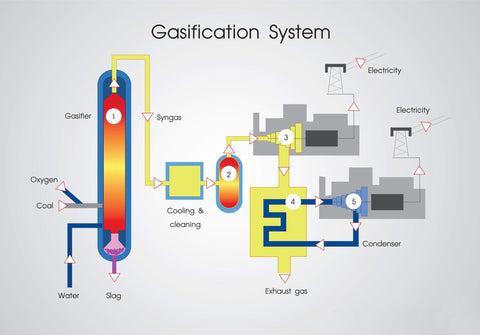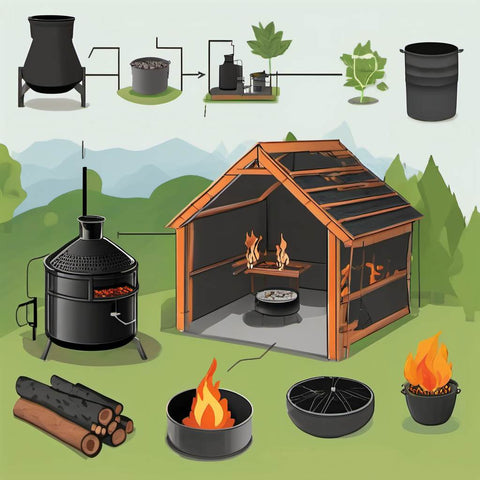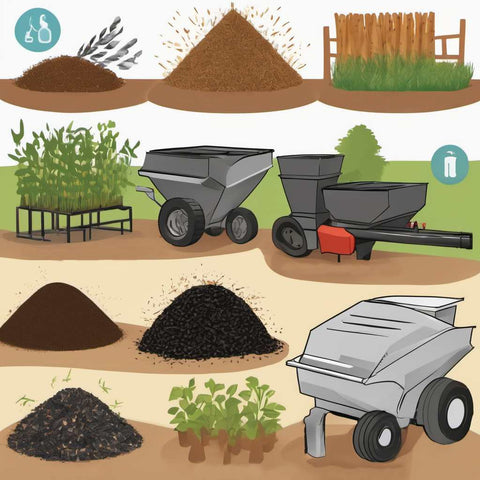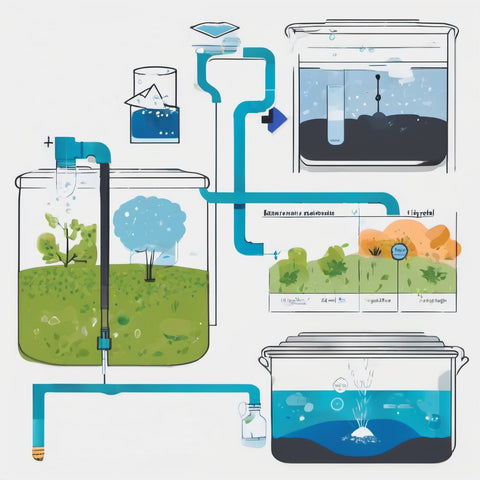Making and Using Biochar Guide: Improve Soil Quality And Plant Health
Biochar For Soil Amendment: Biochar Application for Plant Health

Biochar is rapidly gaining attention as a revolutionary tool for improving soil quality and agricultural yields.
This carbon-rich material is produced during biomass pyrolysis under an oxygen-free condition. It is praised for improving soil quality and helping plants to grow.
Here's a deeper dive into the benefits and applications of biochar in agriculture:
What is Biochar?
Biochar is a blackish material with a reduced weight of carbon and ash obtained from heating the organic material (biomass) under a limited oxygen concentration.
It stands out from other substances with similar properties, such as carbon black, activated carbon, and typical charcoal, mainly due to its production method and its application, especially in agriculture.
Key Benefits of Biochar
Soil Fertility:
Biochar enriches soils by contributing key nutrients such as potassium (K), phosphorus (P), and micronutrients. Its main advantage is that it captures nutrients from many sources and ensures they are not lost away from the plant roots.
Soil Microbial Life Enhancement:
Adding biochar to the soil will noticeably increase microbial activity, resulting in a substantial supply of carbon. This builds soil resilience by improving soil structure and makes long-term carbon sequestration possible, thereby curbing the effects of climate change.
Reduction of Greenhouse Gases:
Using biochar in agricultural soils has been proven to curb the emission of two ecologically significant greenhouse gases, nitrous oxide (N2O) and methane (CH4).
Thus, biochar application is becoming a very crucial element in climate change mitigation efforts.
Applications of Biochar
The unique quality of biochar lies in its application, which extends beyond soil amendment.
These include:
- Soil Amendment: The main application is to improve water filtration, nutrient absorption, and soil aeration.
- Slash-and-Char: Some farmers have started using sustainable cultivation techniques instead of cutting and burning trees, thereby decreasing carbon emissions.
- Water Retention: In addition to slowing down water erosion, biochar helps the soil retain moisture. This becomes important in the production of crops in a region experiencing drought challenges.
- Livestock Feed: A supplementary biochar product in animal diets can reduce methane emissions.
- Concrete Additive: Biochar is regarded as a resource for fabricating eco-friendly building materials that support sustainable construction practices.
- Sources and Longevity

Sources and Longevity
Biochar is synthesized in various ways from organic materials, including crop residues, animal waste, food waste, wood chips, and forestry waste products.
After being put into the soil, biochar's durability becomes an essential attribute, making it long-lasting and capable of lasting for hundreds of years, as proven by the fertile Terra Preta soils of the Amazon Basin.
Impact on Soil and Agriculture
Recent studies accentuate the favorable effect of biochar on soil health, such as improved soil quality, efficient nutrient cycling, decreased nutrient leaching, and stimulation of microbial life.
Ultimately, these benefits contribute to higher crop growth and yields, making biochar a fundamental component of sustainable agricultural thinking.
IN THE FOLLOWING SECTIONS, we will delve deeper into Biochar and the step-by-step process of how to make it.
Understanding Biochar: Biochar Production Process

Biochar, a carbon-rich substance derived from biomass pyrolysis, is emerging as a significant player in sustainable agriculture and environmental management.
Amalina et al. (2022) state that the biochar production process and its subsequent applications offer opportunities and challenges.
Here's a breakdown of the key points regarding biochar's production, benefits, and considerations:
Biochar Production Process
Biochar production is a sustainable process that transforms biomass into a carbon-rich material through various thermal decomposition methods.
Here's an overview of the primary techniques involved:
-
Pyrolysis

This is the main technique for biochar production, where biomass is heated in an environment with limited oxygen. Slow pyrolysis can yield up to 35% biochar from the original biomass, depending on the processing speed, making it highly efficient.
-
Torrefaction

It operates at lower temperatures than pyrolysis, altering biomass into biochar to a lesser extent. Though similar to pyrolysis, it's a milder process contributing to biochar production.
-
Gasification

While its main product is syngas, gasification also leads to biochar production. However, the quantity of biochar produced through gasification is significantly lower than that of pyrolysis.
Biochar's Mechanisms of Action
Biochar's effectiveness in improving soil health and filtering contaminants is primarily due to its unique mechanisms of action, which include:
Adsorption Properties
The biochar structure allows it to remove organic and inorganic contaminants from various environments effectively.
This capability stems from various interactions, such as electrostatic interactions, ion exchange, pore filling, and precipitation.
The specific adsorption capacity of biochar is determined by its physicochemical properties, which vary depending on the biomass source and the production process.
Soil Nutrient Retention
One of the key benefits of biochar in agriculture is its ability to enhance soil nutrient retention.
Biochar's porous nature and surface charge significantly increase its ability to hold onto nutrients, thereby reducing the loss of essential elements like nitrogen and phosphorus through leaching.
This results in improved soil fertility and, subsequently, healthier plant growth.
Comparisons and Considerations
Biochar stands out for its application consistency and versatility, offering distinct advantages over traditional compost, especially regarding quality control and nutrient recovery.
Below is a table highlighting these comparisons and considerations:
|
Aspect |
Biochar |
Compost |
|
Quality Control |
It can be standardized based on feedstock material and production method, ensuring consistent quality. |
Quality varies due to non-decomposable materials and less-controlled production processes. |
|
Nutrient Recovery |
It can absorb nutrients from wastewater, making it an effective medium for soil amendment or acting as a fertilizer, thus supporting sustainable nutrient management practices. |
While it enriches the soil with nutrients, it doesn't specifically adsorb nutrients from wastewater, and its nutrient content is less predictable. |
This comparison underscores biochar's potential to provide a more controlled and efficient solution for soil enhancement and nutrient management compared to traditional composting methods.
Challenges and Environmental Considerations
While biochar presents numerous benefits for soil amendment and carbon sequestration, it also poses challenges and environmental considerations that must be addressed to ensure sustainable use.
These include:
- Ecotoxicity: The impact of biochar on soil, water, and atmospheric health must be carefully considered, as the feedstocks and production processes can influence its ecological safety.
- Soil Health: In certain conditions, biochar application could lead to excessive soil salinity and reduced fertility, particularly in alkaline soils, where it may cause nutrient precipitation.
- Sustainability Concerns: The environmental implications of diverting land for biochar production and the carbon footprint of transporting biomass feedstocks are critical considerations for sustainable biochar use.
While biochar presents a promising avenue for improving soil health, enhancing carbon sequestration, and supporting sustainable agricultural practices, it's crucial to approach its production and application with a comprehensive understanding of its environmental impacts and the best practices for its use.
As research continues to evolve, the potential for biochar to contribute to a more sustainable future becomes increasingly apparent.
The Benefits of Biochar in Gardening and Agriculture

Biochar, derived from biomass pyrolysis under low-oxygen conditions, is celebrated for its potential to revolutionize soil health and agricultural practices.
Its unique properties offer a sustainable path toward soil restoration and catalyze enhancing soil fertility and structure.
Here's an exploration of the multifaceted benefits biochar brings to gardening and agriculture:
Enhancing Soil Fertility and Structure
Biochar's contribution to soil fertility is multifaceted:
- pH and Water Retention: It increases soil pH and water holding capacity, which is critical for arid and acidic soils.
- Nutrient Retention: By improving cation exchange capacity, biochar retains essential nutrients within the soil, reducing the need for frequent fertilization.
- Microbial Habitat: Its complex, porous structure provides an ideal environment for beneficial fungi and microorganisms, crucial for soil health and plant growth. These organisms thrive in the nooks and crannies of biochar, enhancing nutrient uptake by plants.

Improving Water Retention and Nutrient Holding Capacity
Adding biochar to soil significantly impacts water dynamics.
- Moisture Retention: Biochar's internal surface area and pore structure help retain moisture, reduce water loss, and help plants access water during dry periods.
- Drainage and Aeration: Its porosity improves soil drainage and reduces waterlogging while enhancing soil aeration, which is crucial for root health.
- Nutrient Availability: By holding onto nutrients that might otherwise leach away, biochar ensures that plants have access to essential nutrients over extended periods. This quality is particularly beneficial in soils with low fertility or areas where mineral fertilizers are scarce or costly.
Supporting Beneficial Microorganisms in the Soil
Biochar's role extends beyond physical soil improvements to include biological enhancements:
- Microbial Growth: Biochar's pore structure shelters soil microorganisms and promotes their growth and replication. This symbiotic relationship between biochar and soil microbes is vital in organic matter decomposition, nutrient cycling, and soil structure formation.
- Disease Suppression: Biochar can help suppress soil-borne diseases by fostering a diverse microbial ecosystem, reducing the need for chemical pesticides.
- Soil Structure: Over time, the integration of biochar into the soil matrix can lead to improved aggregation, enhancing resistance to erosion and compaction, and further promoting water infiltration and root penetration.
Applying biochar in gardening and agriculture offers a promising avenue for achieving sustainable soil management practices. Its ability to improve soil fertility, structure, and microbial activity, while also contributing to carbon sequestration, positions biochar as a key component in the future of regenerative agriculture.
As we continue to explore and understand the full range of biochar's benefits, its role in enhancing plant health and agricultural productivity becomes increasingly clear.
Making Biochar: A Step-by-Step Guide To Producing Biochar
Making biochar is a sustainable process that transforms biomass into a valuable soil amendment, enhancing soil health and supporting plant growth.
Here’s a comprehensive step-by-step guide to producing biochar, adapted from sustainable practices and research insights:
█ Step 1: Choose Your Biochar Production Method

- Select an Appropriate Burner or Stove: For home use, options range from simple fire pits and chimneas to more sophisticated biochar stoves or biomass gasifiers. Each method has pros and cons, but all aim to create a low-oxygen environment necessary for pyrolysis.
- Considerations: City fire codes may restrict open fires, making enclosed stoves safer and more efficient.
│Pro Tip: Consider the scale of your biochar production when choosing your method. A biochar stove or gasifier designed for efficiency and minimal smoke is preferable for larger quantities. For smaller, experimental batches, a simple fire pit may suffice. Always prioritize safety and efficiency.
█ Step 2: Select the Biomass

- Biomass Types: Suitable materials include crop residues, wood waste, animal manure, and non-food energy crops. The choice of biomass affects the biochar's properties and suitability for different applications.
- Size and Consistency: Ensure the biomass is uniformly sized to promote even pyrolysis. Using a wood shredder can help achieve consistent particle sizes.
│Pro Tip: Aim for a diverse mix of biomass to create biochar with a balanced nutrient profile. Mixing different types of organic materials can improve the overall quality of your biochar. Ensure that all materials are clean and free from contaminants.
█ Step 3: Preparation and Pyrolysis

- Dry the Biomass: Ensure the biomass is adequately dried to improve pyrolysis.
- Pyrolysis: Heat the biomass in your chosen device, maintaining a low-oxygen environment. Monitor the process closely to ensure complete conversion to biochar without burning to ash.
- Safety Note: Always follow safety guidelines for handling fire and high temperatures.
│Pro Tip: To optimize the pyrolysis process, cut your biomass into uniform pieces to ensure consistent heating and conversion. The smaller the pieces, the more efficiently they'll pyrolyze, but balance this with the practicality of processing large quantities of material.
█ Step 4: Quenching and Processing

- Quenching: Once the pyrolysis process is complete, use water or exclude air to extinguish the biochar to stop the burn.
- Crushing: If necessary, break the biochar into smaller pieces to increase its surface area and effectiveness as a soil amendment.
│Pro Tip: When quenching biochar, consider using collected rainwater to minimize waste. If breaking biochar into smaller pieces, wear protective gear to avoid inhaling dust particles. A simple mask and goggles can protect your lungs and eyes.
█ Step 5: Removal of Contaminants

- Leaching Salts: Soak the biochar in water to remove soluble salts that could harm plant growth. Multiple soakings may be necessary to reduce salt content sufficiently.
- Adjusting pH: If the biochar is highly alkaline, soaking can also help lower its pH to more suitable levels for garden and agricultural use.
│Pro Tip: Use a pH meter to test the water during soaking to monitor alkalinity reduction in your biochar. Changing the water when it reaches a high pH can make the leaching process more efficient.
█ Step 6: Enriching Biochar

- Mix with Compost: Combine biochar with compost or manure to enrich it with nutrients. This step is crucial for transforming biochar from a simple carbon structure into a nutrient-rich soil amendment.
- Curing: Allow the mixture to age for several weeks, enabling the biochar to adsorb the nutrients from the compost.
│Pro Tip: For an extra nutrient boost, consider soaking your biochar in a nutrient-rich solution, such as compost tea, before mixing it with compost. This can increase the biochar's nutrient-holding capacity right from the start.
█ Step 7: Applying Biochar to Soil

- Application Rate: Determine the appropriate amount for your soil type and the crops you intend to grow. A general guideline is to incorporate about 1% biochar by weight into the top 6 inches of soil.
- Mixing with Soil: Thoroughly mix the biochar into the soil or compost to ensure even distribution.
│Pro Tip: When incorporating biochar into your soil, do so gradually to observe how your plants respond. Starting with a lower application rate and increasing it based on plant health and soil improvement can prevent over-application and maximize benefits.
Considerations for Use
- Avoid Overuse: Excessive amounts of biochar can lead to soil imbalances. Start with smaller applications and observe plant response.
- Continuous Application: Biochar’s benefits accumulate over time. Regular additions to the soil should be considered to continually improve its fertility and structure.
This guide outlines the basic steps for producing and using biochar in gardening and agriculture.
By following these steps, gardeners and farmers can create a valuable soil amendment that boosts soil fertility, supports microbial life, and contributes to sustainable land management practices.
For more DIY biochar production, kindly refer to the video attached below.
Conclusion: Biochar Properties For Improving Soil Health
The sustainable use of biochar solutions has the potential to be a defining factor in soil management, significantly contributing to soil health enhancement.
Agriculture and gardening may use it to increase soil fertility and nutrient retention, and this process goes beyond solving environmental challenges.
By integrating biochar into soil management practices, individuals can partake in the global efforts to:
- Enhance Soil Quality: Biochar is unique in its ability to improve the physical properties of soil, increase water retention and nutrient availability, and boost plant health and agricultural productivity.
- Conserve Resources: With the aid of biochar, farmers can reduce their use of chemical fertilizers, which naturally encourages the efficient use of natural resources and the diminishment of agricultural runoffs.
- Mitigate Climate Change: By sequestering carbon and reducing emissions of potent greenhouse gases like nitrous oxide and methane, biochar helps mitigate climate change and diminish the impact of global warming.
- Sustain Biodiversity: By improving soil conditions, biochar allows the proliferation of soil microorganisms, which is the basis of the biodiversity of the entire ecosystem.

The role of biochar in agriculture and environmental sustainability is gaining importance, which emerges as an optimistic solution for improving soils, conserving resources, and combating climate change.
Its broad application across soil amendments underscores its value in preventing nutrient loss, retaining moisture, and detoxifying pollutants.
In the coming years, the farming sector and avid gardeners will recognize biochar as a key component of an environmentally friendly approach and in the struggle against climate change.
Using biochar as a soil amendment confers multi-beneficial effects on agricultural practice, aligning with the call for sustainable agriculture and environmental protection.
Going ahead, the role of biochar in the renewable energy sector will be pivotal in building a sustainable world for our planet.
Whether in small garden plots or large agricultural fields, using biochar is a step toward an environmentally conscious and more resilient approach to treating soil health and promoting plant growth.
📖Further Readings:
